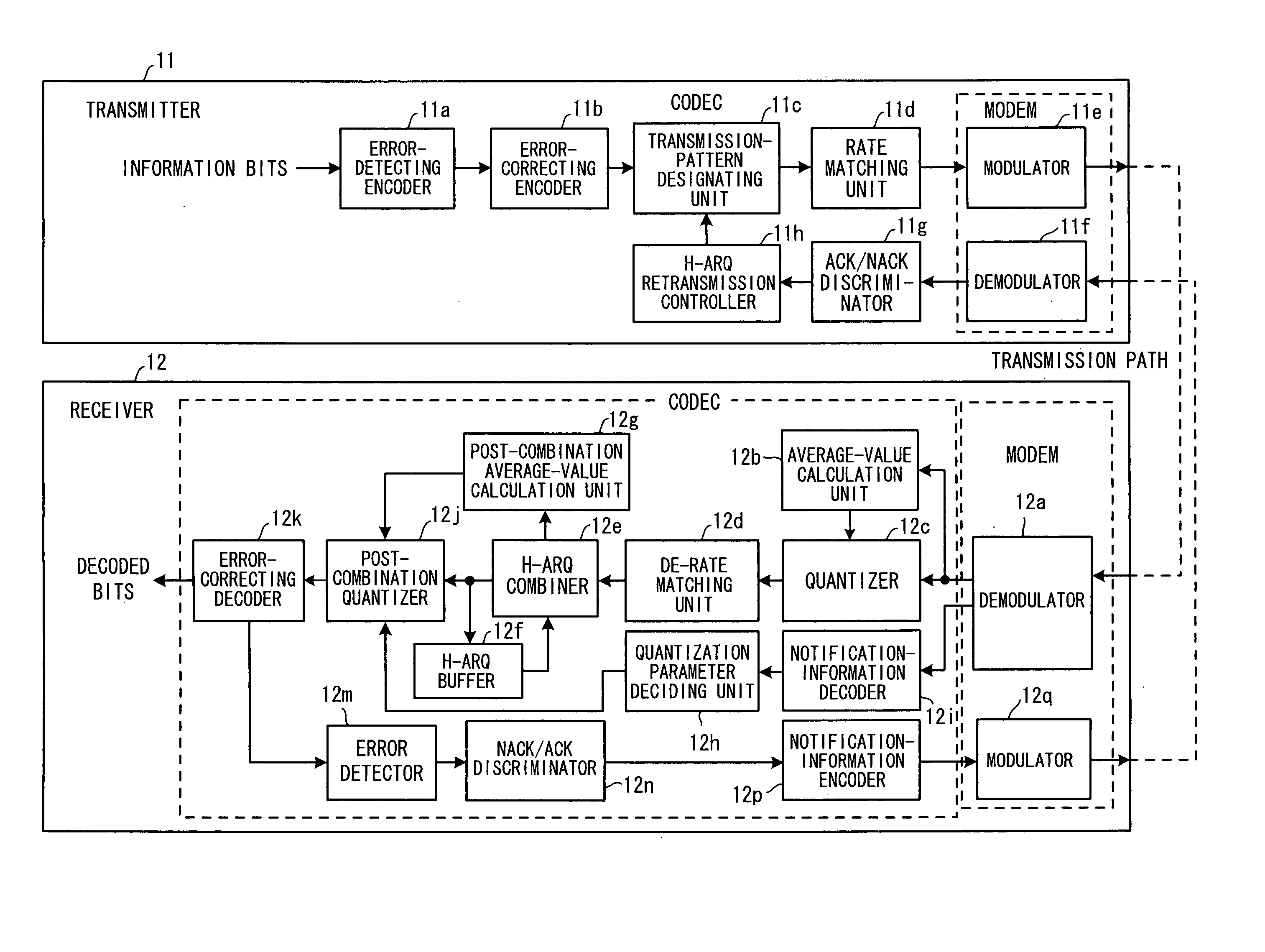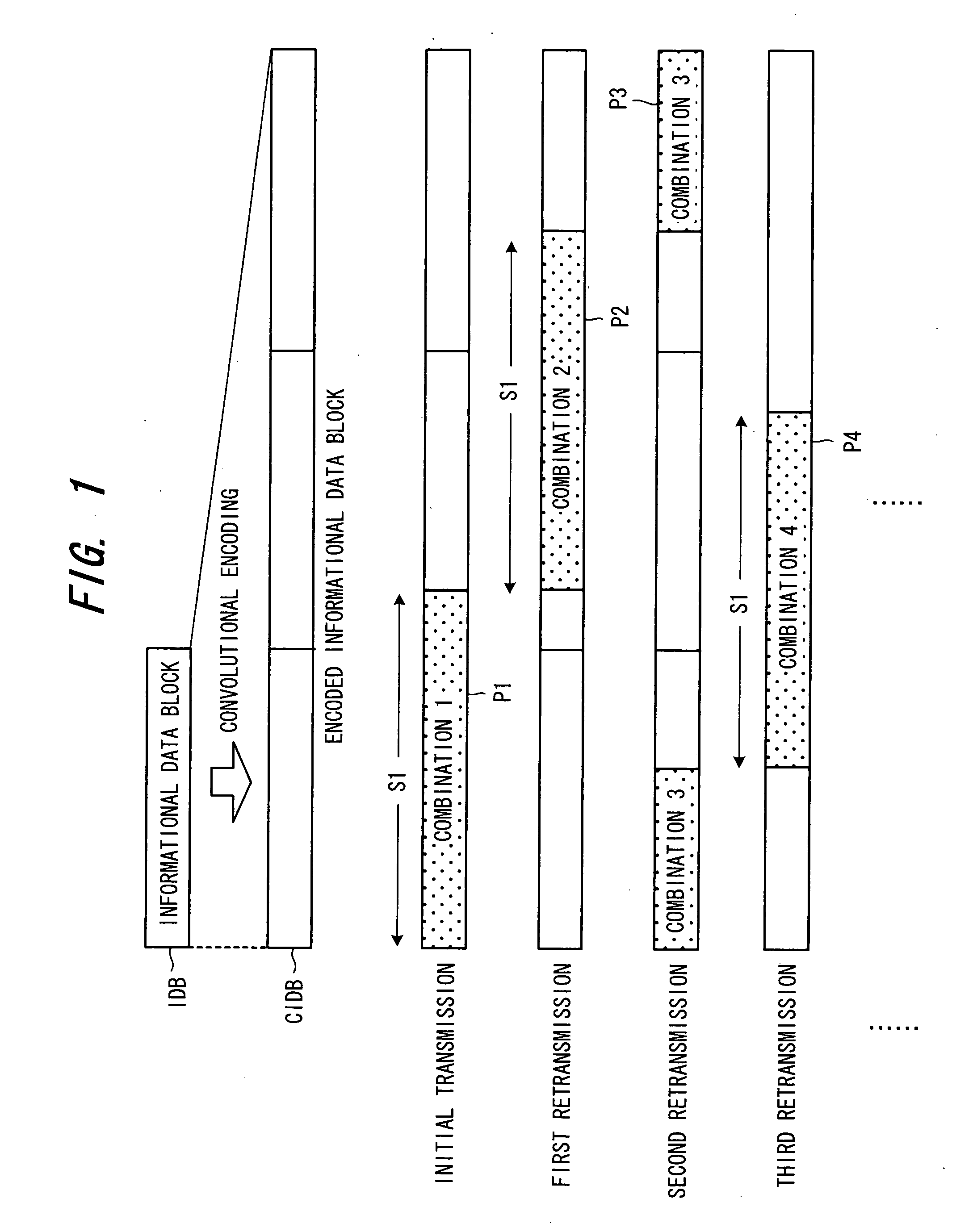Communication system and receiving method
a communication system and receiving method technology, applied in the field of communication systems and receiving methods, can solve the problems of small size, decoding failure, and quantization method not necessarily the optimum, and achieve the effect of reducing quantization error and improving characteristics
- Summary
- Abstract
- Description
- Claims
- Application Information
AI Technical Summary
Benefits of technology
Problems solved by technology
Method used
Image
Examples
first embodiment
[0080] (B) First Embodiment
[0081]FIG. 1 is a diagram useful in describing a retransmission pattern according to a first embodiment of the present invention. It is assumed that a nonsystematic code having an encoding rate of ⅓ is used as an error-correcting code in an H-ARQ communication system. In a case where a transmitter transmits a new informational data block, the transmitter appends CRC parity and then performs encoding. The size of an encoded informational data block CIDB is approximately three times the size of an informational data block IDB before encoding owing to the encoding rate of ⅓. However, there are cases where size S1 of a packet transmitted at one time is smaller than the size of the encoded informational data block CIDB, and in such cases puncturing processing is applied to the encoded informational data block. The transmitter transmits a packet P1 of a combination 1 at the time of a first transmission, a packet P2 of a combination 2 at the time of a first retra...
second embodiment
[0090] (C) Second Embodiment
[0091] In a second embodiment, use is made of a systematic code having an encoding rate of ⅓, as illustrated in FIG. 3, as the encoding method. Further, the size of packets P1 to P4 is exactly ⅓ of the encoded informational data block CIDB, and it is assumed that retransmission is in accordance with the illustrated patterns.
[0092]FIG. 4 is a block diagram of a transceiver according to the second embodiment, in which components identical with those of the first embodiment are designated by like reference characters. The operation of the transmitter 11 is the same as that of the first embodiment. The method of deciding the quantization range and quantization levels in the receiver 12 differs from that of the first embodiment. More specifically, in the first embodiment the quantization range and quantization levels in the post-combination quantizer 12j are decided using the encoding rate sent from the OB area 11. In the second embodiment, these are decided ...
third embodiment
[0098] (D) Third Embodiment
[0099] A third embodiment of the invention is constituted by a system the basis of which is a channel that supports HSDPA (High-Speed Downlink Packet Access) compliant with 3GPP Release 5. Here a base station and mobile station correspond to the transmitter and receiver, respectively. FIG. 5 illustrates an example of retransmission patterns, and FIG. 6 is a block diagram of a transceiver according to the third embodiment, in which components identical with those of the second embodiment of FIG. 4 are designated by like reference characters.
[0100] The H-ARQ method, which is one HSDPA technique, is used as an HS-DSCH (High-Speed Downlink Shared Channel) in a W-CDMA system compliant with 3GPP Release 5. When the base station 11 initially transmits an information bit block (transport block) of the HS-DSCH transport channel, the base station executes a series of encoding processes (appending of CRC parity and execution of turbo encoding processing), executes r...
PUM
 Login to View More
Login to View More Abstract
Description
Claims
Application Information
 Login to View More
Login to View More - R&D
- Intellectual Property
- Life Sciences
- Materials
- Tech Scout
- Unparalleled Data Quality
- Higher Quality Content
- 60% Fewer Hallucinations
Browse by: Latest US Patents, China's latest patents, Technical Efficacy Thesaurus, Application Domain, Technology Topic, Popular Technical Reports.
© 2025 PatSnap. All rights reserved.Legal|Privacy policy|Modern Slavery Act Transparency Statement|Sitemap|About US| Contact US: help@patsnap.com



